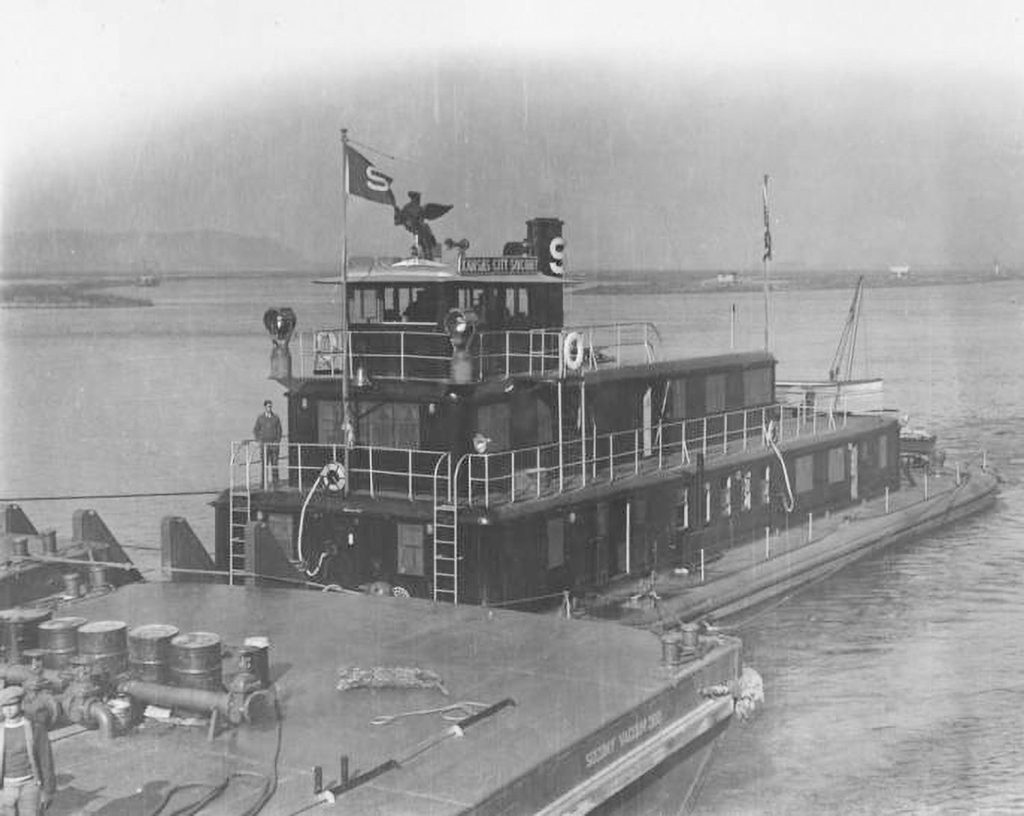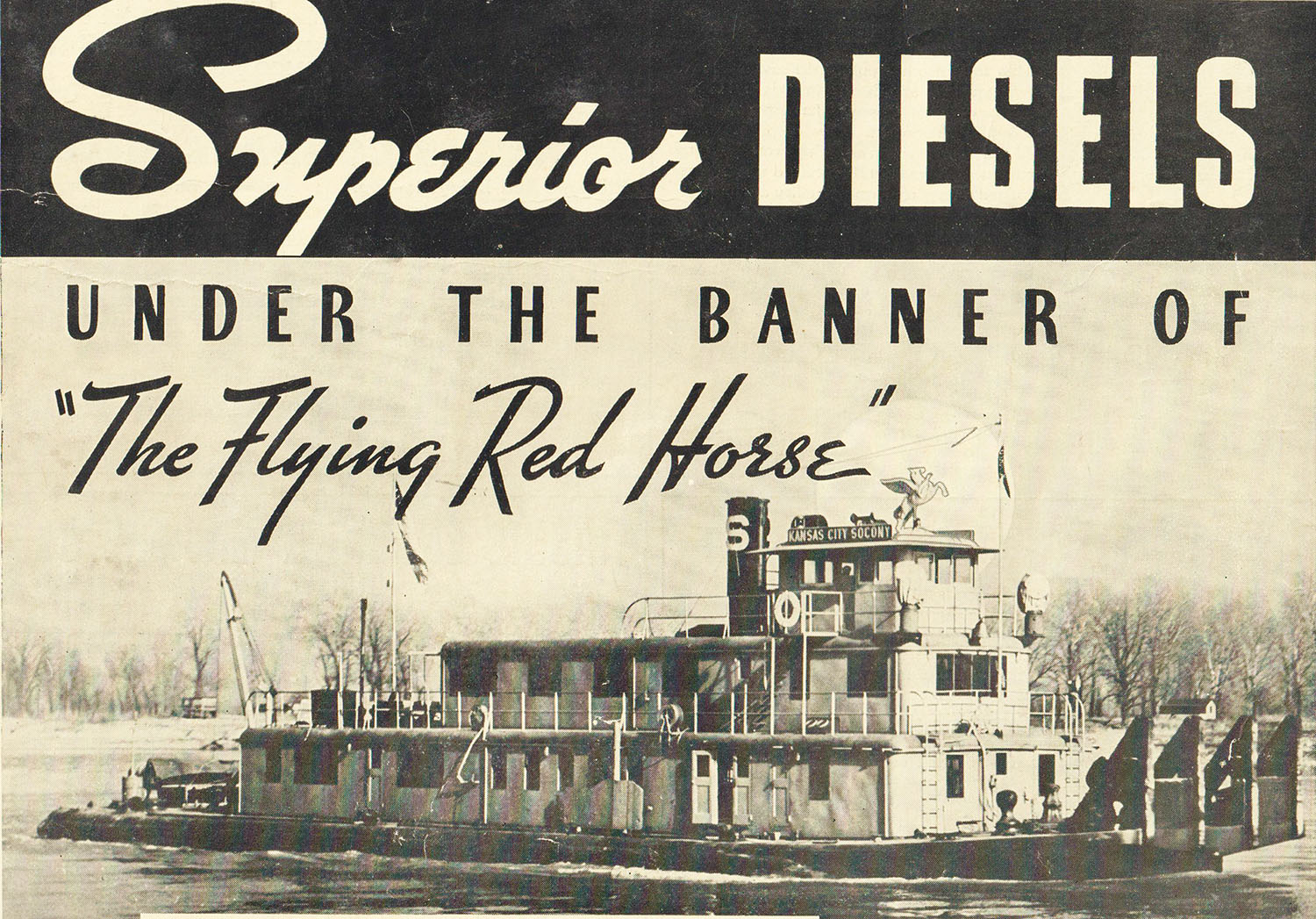Capt. Phil C. Elsey was one of the founders of the Sons & Daughters of Pioneer Rivermen. A group of river personages gathered at the Hotel Lafayette in Gallipolis, Ohio, in 1939 to form that institution that even today, along with the S&D Reflector, their signature quarterly, is “Lighting Up the Past, Present, and Future of the Mississippi River System.” Capt. Elsey was the dinner host for the event and was named the first vice president of the fledgling organization.
Capt. Elsey, from Pittsburgh, was a son of Capt. Warren Elsey, the river superintendent of the Jones & Laughlin Steel Corporation. Capt. Phil rose through the ranks of J&L himself, becoming a pilot and master with the Vesta Coal Company, the river transportation division of the steel conglomerate. He later took his father’s place as superintendent before forming his own firm in 1929 called Elsey River Transportation Company, which operated two steam sternwheel towboats. The ensuing Great Depression caused the company to fail soon after, and from 1930 to 1934 Capt. Elsey stood pilot watches on the towboat Leona and the excursion steamer Washington (WJ July 25, 2022). He then joined the Raymond City Coal & Transportation Company as transportation manager.
The Raymond City concern towed coal from the Kanawha River to their terminal at North Bend, Ohio, just below Cincinnati. While superintendent of this company, Capt. Elsey was often mentioned in the pages of The Waterways Journal, in the news columns from Cincinnati and Kanawha River, as well as quotes from his letters to the WJ reported in the Personals columns. The January 2, 1937, issue of the WJ carried a note in the Pittsburgh column on page 6 that Capt. Elsey had spent the holidays in his hometown. On the same page was a very small, single paragraph story about the Kaw Point Boat & Motor Company of Kansas City, Kan., having been “awarded a contract from the Socony Vacuum Oil Company of New York for the construction of a fleet of four tank barges for service on the Mississippi, Ohio and Missouri rivers.” The barges were to have a capacity of 8,000 bbl. each.
The July 24, 1937, WJ had a story on page 7, next to the masthead. that was headlined “New Socony-Vacuum Boat Launched At Kansas City.” The name selected for the boat was, appropriately, Kansas City Socony. Intentions were for the boat to tow oil barges from Socony facilities being built in the Kansas City suburb of Fairfax, Kan., to a new terminal at St. Paul, then under construction by Socony. The last line of the item said, “The boat’s operations will be under the supervision of Capt. Phil C. Elsey, formerly of Pittsburgh and Cincinnati.” Elsey had obviously been lured away from Raymond City by Socony.
The Kaw Point Boat & Motor Company had also undergone some changes. The firm had been formed in 1929 by Kenneth R. Elliott (who was only 16 years old at the time). Due to the large Socony contracts, the company site expanded upstream to Fairfax, Kan., and the name was changed to Elliott Fairfax Shipyard. The new Kansas City Socony was entirely of steel construction with a hull 125 by 32 feet. It had a long upper cabin, and the pilothouse was located above that, situated forward with a single smokestack aft of it. Though of a somewhat squarish design, the boat had a pleasing appearance with the outer edges of the cabin roofs rounded outward. It was powered with a pair of Superior diesel engines that developed 1,020 hp.
This first boat of the Socony river fleet was painted in a dark red color. A large white “S” adorned each side of the black stack. Crowning the roof of the pilothouse was a sizable figure of Pegasus, the mythical winged horse that Socony had adopted as part of its logo. While the boat was being outfitted at Kansas City, Capt. Elsey made a posting trip down the Missouri River on the Federal steamer C.C. Webber to inspect the channel, as reported in the St. Louis News column of the August 21, 1937, WJ. He had told the WJ staff that the new Socony terminals at Kansas City (Fairfax) and St. Paul were now ready for service, and the new boat was expected to depart from Kansas City for St. Paul with the first two barges of gasoline about the middle of September.
The Kansas City Socony departed Kansas City, Kan., with the first tow of gasoline shipped from that area 86 years ago this week, on September 23, 1937. The Kansas City Star was on hand and ran a story about the departure, along with a photo of the boat and two barges clearing the Hannibal railroad bridge. It was a rough first trip. The Missouri River was at a low stage, and many trouble spots were encountered. The U.S. Engineer Department assisted by surveying and dredging in these areas. Not long after getting underway, the new boat experienced a shaft bearing failure. It stopped at the Engineer Boatyard at Gasconade, Mo., to make repairs, and it finally reached St. Louis on October 14. From there, Capt. Harry Lancaster joined the crew as pilot, and the tow continued northbound on the Upper to St. Paul. The October 23 issue of the WJ reported that this first gasoline tow into the Socony dock at St. Paul arrived on October 19 with the boat “flying all its flags.” The trip had taken 28 days, but it was judged a success. Socony announced plans to build five more towboats and 20 additional barges over the next three years.

The Kansas City Socony settled in to towing petroleum products to and from Socony Vacuum facilities on the Mississippi and Missouri rivers. It also continued to add to the record of “firsts.” In June 1939, it delivered the initial tow of gasoline into Omaha, Neb., and a year later arrived with the first such tow at Sioux City, Iowa, both cities located in the upper navigable reaches of the Missouri River.
Socony added the 1,200 hp. St. Louis Socony to the fleet in 1938, and the 1,500 hp. St. Paul Socony was built in 1940. After the delivery of the 3,200 hp. La Crosse Socony by St. Louis Ship in 1951, the company decided to sell the original workhorse of their stable, and the Kansas City Socony went to new owners. The rest of that boat’s history will be detailed in the next column.
Due to continuing effects of the depression, the Elliott Fairfax Shipyard closed in the early 1940s. Mr. Elliott went on to found a successful hydraulics and worm gear company in Illinois. Capt. Phil Elsey left Socony, and in 1940 was with Armco Steel Corporation, Middletown, Ohio. He assembled a fleet of river steamers for them and served as superintendent of river operations with offices at Huntington, W.Va., until his retirement in 1959. He passed away at Huntington on July 17, 1968, at age 78.
(Note: The text was edited September 19, 2023, to correct a typo in the dimensions of the dimensions of the Kansas City Socony.)
Caption for top photo: Kansas City Socony in a front-cover WJ ad for Superior diesels, May 21,1938. (David Smith collection)
Capt. David Smith can be contacted at davidsmith1955obc@gmail.com.




